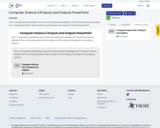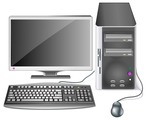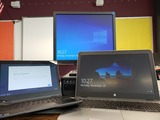
Introduce cause/effect and input/output to students, then complete a related scavenger hunt.
- Subject:
- Computer Science
- Computing Systems
- Material Type:
- Lesson Plan
- Author:
- C. Hope Adams
- Emily Kidd
- Jennifer Nelson
- Date Added:
- 12/07/2021

Introduce cause/effect and input/output to students, then complete a related scavenger hunt.

Use the Google Jamboard to sort devices by input or output function.

This is a PowerPoint presentation that covers the essential knowledge of the Computer Science standard 3.8 on Computing System about systems and the inputs and outputs of computing systems.

This Quizlet Study Set contains Elementary (K-5) vocabulary from the "Computing Systems" strand of the Virginia Standards of Learning for Computer Science. Students can study the terms with flashcards or try the games to test their knowledge.

This slides presentation has a short video about the 4 things that all computing devices have in common and then has picture examples of Input and output devices. It also has a slide of internal components we don't usually see.The final slide is a sorting activity that includes input and output devices.

Students will be able to explore the different continents by correctly locating them through various materials! Using the medicine ball, puzzle globe, and 3d doodler pens, students will engage in an exciting activity that helps them understand the location of the different continents. Dive into the different continents and allow your students access to expand their knowledge using creativity!

This is a self-paced review of input and output definitions and devices. Students will click on hyperlinks to check their understanding of input and output devices.

This is a document in which students can use to compare different parts of the computer as to weather they are used for input or output of data.

Students will be able to explore the different continents by making a model of a continent of their choice! Using the globe, modeling clay, placemats, and other tools, the students will be able to use their creativity to produce a model of a continent. Dive into the different continents and allow your students access to expand their knowledge using creativity!

Students will draw a computer system using the main 5 parts as included in the PDF download3.8 The student will model how a computing system works including input and output.

Do you want to show your students in a fun way how an ecosystem collapses if a species is removed? Check out this lesson using squishy circuits (that’s play dough and safe circuits)! Students will get to learn about ecosystems and circuitry all at the same time.

This lesson allows student teams to learn some basic coding skills, play with a robot, and learn about hardware, software, input, and output, all while learning about the major geographic features of Africa. Students will be engaged and excited while reinforcing their learning.

Using robots to help identify different geographic features of North America.

Your students will use Kitchen Chemistry to make a tasty treat as they learn about input and output devices and phases of matter!

Students will actively model a sorting network by using what they know about comparing and ordering numbers to learn how computers use algorithms to sort things.